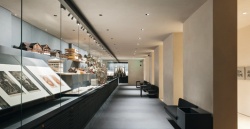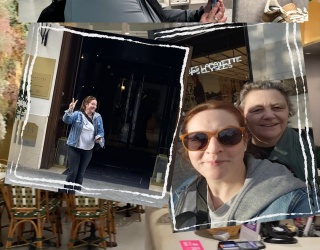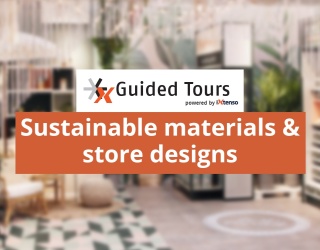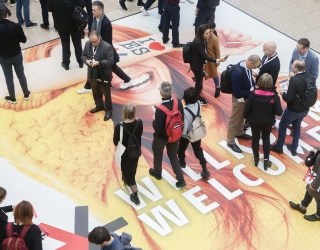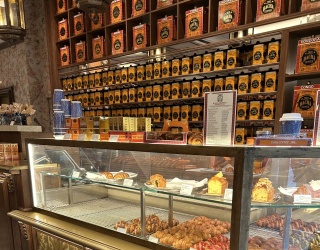Following a four-year conversion period, the “vorarlberg museum” in Bregenz will open its doors again on 21 June 2013. The museum designed by the Bregenz-based architectural studio Cukrowicz Nachbaur has now become one of the highlights of the city's cultural landscape. In order to meet the demanding lighting requirements of the various areas of the museum, the designers opted for a project-specific lighting solution by Zumtobel.
The new “vorarlberg museum” is an architectural and cultural gem situated on a prominent location right at the heart of the city of Bregenz. For as long as 150 years, it has been preserving cultural and artistic testimonials from the region of Vorarlberg. This time-honoured art collection has now been turned into a contemporary museum that arouses the visitor's interest already from the outside. The concept developed by Cukrowicz Nachbaur architects is based on the principle of continued building, combining tradition and progress in the region of Vorarlberg in a fascinating way. The heritage-protected three-storey administrative building was extended in height and supplemented with a new five-storey annex. The onlooker's gaze is immediately drawn to the facade's unusual relief that is characterised by 16,656 randomly arranged castings of PET bottle bottoms. They are intended to illustrate Vorarlberg's standing as a business location of international relevance, since the region accommodates the headquarters of Alpla, the world's market leader in packaging solutions. Inside the building, various exhibition areas form the heart of the museum; they posed the greatest challenge in terms of selecting the right lighting system. Therefore, the designers and architects relied on Zumtobel's expertise when it came to presenting some 150 years of history of Vorarlberg.
90 percent custom solutions to achieve perfect illumination
An important aspect in the building's redesign was to find a perfect lighting system for the various areas of the museum that can also be adjusted flexibly and quickly. In collaboration with lighting designer Manfred Draxl and with structural and technical requirements in mind, Zumtobel developed a customised lighting concept for the museum that combines efficient and gentle lighting with high lighting quality and perfect colour rendering. Moreover, all areas of the museum are uniformly lit with a warm white colour temperature of 3000 kelvin – this creates perfect lighting conditions for the exhibits as well as a pleasant atmosphere for both visitors and staff members.
About 90 percent of the lighting solution are custom solutions, including more than 1400 special luminaires. Furthermore, Zumtobel developed so-called multi-functional mono-points (MMP) for the exhibition areas and the foyer, which allowed unobtrusive homogeneous installation despite the building's slightly conical layout. MMPs are concrete casting boxes with a diameter of 90 millimetres. Recessed into the ceiling along a grid, they allow flexible integration of luminaires, loudspeakers or heavy-duty elements. The MMP automatically detects when a luminaire is installed and connects it to the central Luxmate Litenet lighting management system. Using Luxmate, the museum's entire lighting solution can easily be controlled with high precision. The system combines complex qualities to form a central unit that can be operated and configured thanks to especially developed graphic user interfaces via smartphones and tablets. In addition, Zumtobel has developed a special addressing concept for the illumination of exhibition spaces which allows for luminaires installed in retrospect to be integrated into the existing lighting solution immediately.
Innovative luminaires for demanding tasks
For uniform vertical illumination of walls, with the light centre at eye level, Zumtobel used wall-washers as suspended pendant luminaires with a length of 470 millimetres. Moreover, two pivoting LED luminaires – a simple recessed spotlight and a suspended version with five integrated spots – enable accent lighting of the exhibits. Above all, they boast very high colour rendering (Ra > 90) and excellent lighting quality. Their UV- and IR-free light is also particularly gentle on the exhibits. This combination is also used in the show depot where special objects are presented behind glass panels. Here, the luminaires are mounted on Tecton trunking. Tecton is a continuous-row lighting system which, thanks to its built-in 11-pole current conducting section, connects the luminaires with all functions such as power supply or lighting control. This allows absolutely flexible mounting positions and reduces costs for both installation and maintenance. Thus, additional luminaires can be added to the Tecton trunking for special exhibitions.
For perfect illumination of the foyer, Zumtobel relies on a combination of custom-made LED downlights, LED spotlights, HIT downlights and halogen spotlights. In the next room, the light-flooded atrium, daylight is enhanced by soft indirect lighting provided by minimalist Arcos spotlights.
In the museum café, Zumtobel added a decorative lighting installation consisting of some 30 halogen luminaires with fabric shades providing cosy light that entices guests to stay for a while.
In the administrative area, mainly luminaires with fluorescent lamps are used. Thus, the Freeline luminaire as pendant luminaire achieves perfect lighting conditions in the offices, thanks to its uniform light distribution. In the rooms where events are to be held, special lighting systems fitted with fluorescent lamps and halogen lamps provide both pinpoint and linear lighting. For the staircase of the new building, Zumtobel has developed another LED downlight, taking into account the sloped ceiling. In the staircase of the old building, the challenge was to follow the contours of the historic window arches and produce an appropriate light distribution.

